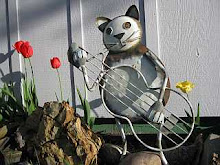I couldn't check the pasture grass until mid afternoon as it had been raining all morning. We are in a period of several dry days, then several wet days. The rain had started last Friday night before 9 pm. After finishing the dig of my garden Friday night I decided to mow the grass in the garden/fruit tree area around the garden, strawberry, and raspberry patches. The better for my eventual weeding of the strawberry patch.
This was my first time mowing this year, as having read my earlier posts you know I had let my "girls" mow my lawn and fruit tree area earlier. As the 12 "girls" were a handful I knew that 28 cattle would be insane. I may be crazy but I'm not insane. Besides, while tall enough to mow, the grass wasn't tall enough to make it worth letting the cattle in.
After mowing part of the garden/fruit tree area, I mowed around the house and buildings, then part of the front driveway. My car is low and the grass tickles the car's underside as I drive in my driveway. A light rain had started and was steady but mowing the lawn creates body heat and I barely felt the rain. I mowed until the gas ran out.
I finished mowing the lawn Sunday afternoon. The grass was still damp in areas but I couldn't wait. I could already see in less than 48 hours how the mowed areas of the lawn were starting to regrow.
Back to my cattle... Saturday afternoon after the rain finished I checked the north pasture. It's time to move. What little tall grass there was here and there was not worth the effort to remove. I opened the gate then walked to the river to get the herd. They saw me coming and came to meet me. They followed me, excitedly, to the gate.
At first most didn't notice the gate was open as they were focused on me, but after the first few went through the rest quickly followed. In the tall grass they got down to business and the sounds of "rip, rip, munch, munch" filled the damp post-rain air.
As I planned to lock the cattle out of the north pasture I had to move their salt blocks. The wooden stand to hold the salt was at the south end of the middle pasture under a large pine tree that kept the salt dry in its rain shadow. I used a wheelbarrow to move two large blocks from the north pasture. I found the stand was getting loose and wobbly, even though I had nailed and tightened it up last summer. I got some wood, nails, hammer and a saw and added to the stand and nailed it good. I also added pieces of wood to the stand's legs. In the past the cattle would sometimes tip the stand over. With the large "feet" it should be harder to tip.
While excited to be in a new pasture, and moving here and there to check things out, some cattle were still curious as to what I was doing. They took a break from eating to check out the stand and my tools. At least I now know they know where the salt blocks are.
After fixing the stand I sat and watched the cattle. This was the first I had really looked at Dan's cattle. His cattle look really nice. Their coats are sleek and healthy. His full blooded Hereford heifer is quite pretty with its red and white. Even his two "magpies" (Holsteins) look good even if bonier and more ungainly than the rest of the cattle breeds. I like the Holsteins. Their black and white stands out even when down by the river. I can see where the herd is by them. The black cattle blend in and hide in the tall grass.
After several days the cattle seem to be happy in their new field. I brought the remaining two salt blocks and their wooden stand from the corral area into the middle pasture. I placed them under a large pine towards the north side of the pasture. That should be plenty of salt for them. The salt is on the east side of the pasture to encourage them to visit the east side once in a while so I can easily see them and sometimes count them. They have their routine and favorite trees under which to take their siestas. It is sometimes hard to see them in the shade or tall grass, even when on the east side of the pasture.
Happy cattle are good cattle. ...usually.



No comments:
Post a Comment